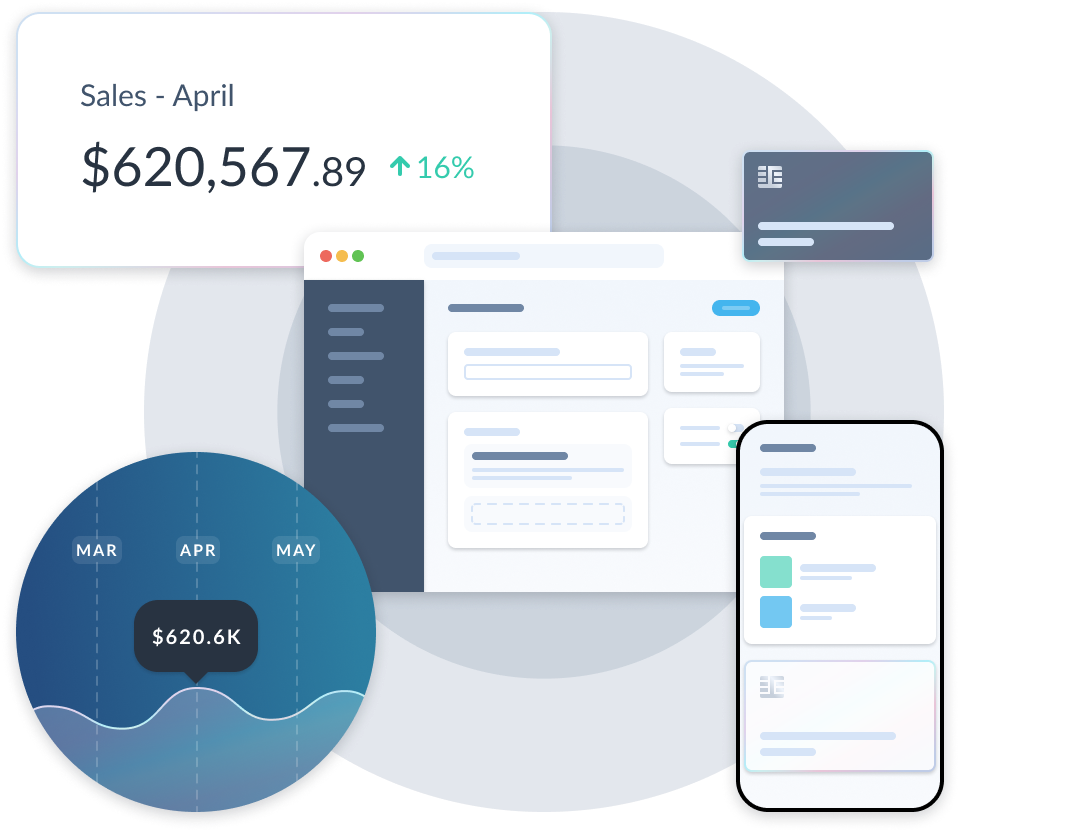Commerce Platforms vs Commerce Infrastructure
In this post we explore what a commerce platform is, the pros and cons of one, and why we’ve decided to take an infrastructure led approach to commerce. We’ll explore why building on top of infrastructure is advantageous to a business’s technical architecture and operational efficiency vs trying to wrestle with a bloated platform.
But first, let’s define what a platform is and understand the dynamics that lead to outgrowing one.
Defining the platform
A platform is typically the first thing that springs to mind when you’re thinking about how your business operates online. It’s easy to understand and makes sense; on paper you get a collection of features out of the box that all work together. You think you’ll need and use all or most of these features and that you can launch really quickly with a template driven experience. There’s a supporting ecosystem of third party vendors to compliment the platform and a proprietary framework that allows you to extend the platform based on your requirements now and in the future.
A commerce platform is essentially the central operating system that your business runs on but also dictates what you can and cannot do.
Outgrowing the eCommerce platform
As your business grows, you’ll typically begin to enhance your customer experience to improve conversion rates, customer satisfaction, and your bottom line. In addition, you will likely need to improve your internal business processes as you scale up to meet this new demand.
As you scale you’ll likely use more of a commerce platform’s feature until you exceed what is offered out of the box. At this point you have a choice; do you look to the existing ecosystem of plugins or integrations that enhance this platform, or build something yourself? Typically the answer is the former and over time you install dozens of 3rd party plugins and begin to replace commerce platform functionality. It starts to become more challenging to extend the platform over time and you’re now heavily invested in customizing it to meet your needs.
Businesses using a platform but who have outgrown the app and plugin ecosystem, now find themselves in the uncomfortable position of wanting to re-platform to meet their business goals. Failing to do so, quickly puts the business at risk of being overtaken by a competitor or becoming irrelevant in the eyes of the customer.

Flavours of commerce
Before we dive into a definition of commerce infrastructure, let's briefly explore the different spectrum of commerce software you can leverage and their pros and cons.
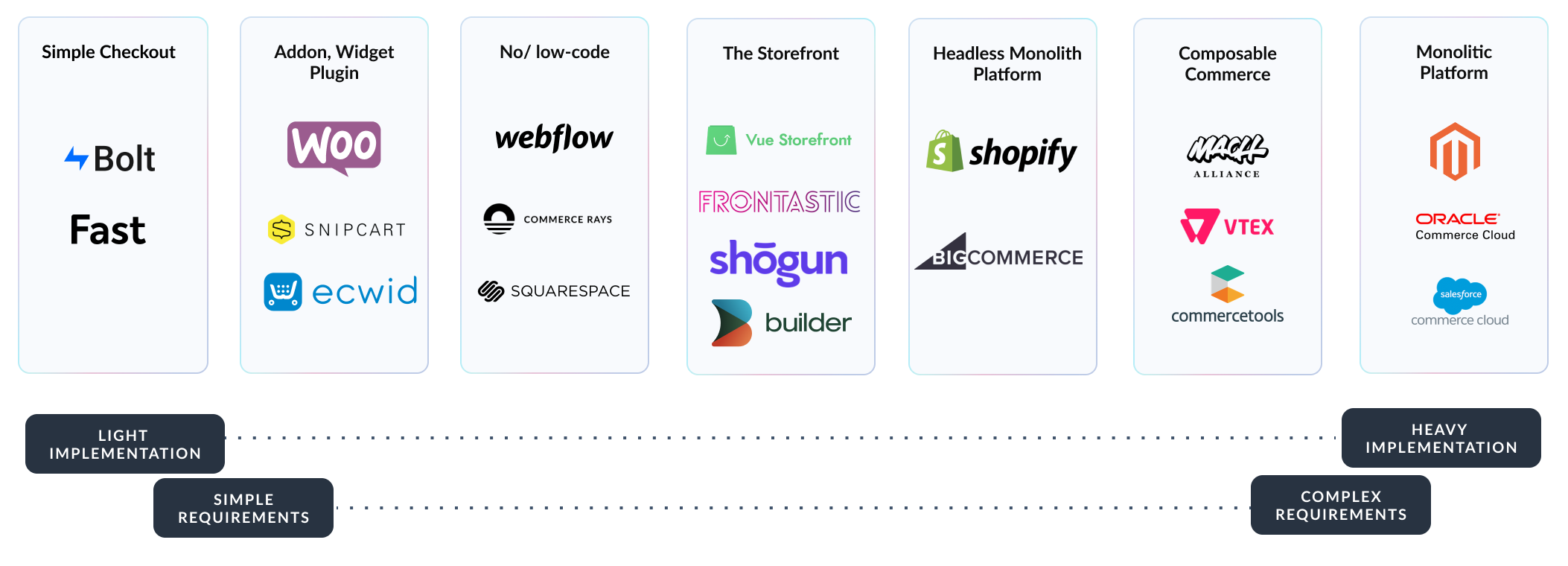
The simple checkout
Definition: A simple checkout that streamlines the checkout experience for the end customer with a standardized checkout form.
Good for: Those with an existing commerce platform, simple checkout requirements and those looking to make it easier for customers to checkout. Suited for low $ value, high purchase frequency products like FMCGs.
Not good for: Those that have complex or custom checkout requirements due to their business model or a strong desire to control the checkout experience and wider customer journey.
Vendors: Fast, Bolt
The addon, widget, and plugin
Definition: These commerce solutions are typically embedded directly into the frontend code of your website via short JavaScript snippets and HTML tags to render commerce data via API requests. Older solutions may leverage iframes. An addon may be a CMS vendor commerce plugin that can be installed within the proprietary CMS framework. Are partially customizable/flexible.
Good for: Those with an existing legacy CMS or Jamstack/static site that does not offer commerce functionality out of the box. Great for those that want to add some simple commerce cart and checkout functionality to their existing website.
Not good for: Those businesses who have commerce at the core of their business model and will need to create deeper customizations and integrations over time.
Vendors: Snipcart, Ecwid, Shopify Buy Button, Bold Commerce, WooCommerce
The Storefront
Definition: Storefronts are the head in headless commerce. They typically provide a toolkit, framework, and starting point for developers to craft their own frontend experiences in headless implementations. They do not come with a backend commerce platform but instead hook into existing eCommerce solutions via APIs.
Good for: Those that want to rapidly roll out a custom storefront in a particular flavour of JavaScript without building everything from scratch.
Not good for: Those that do not have development teams and the experience required to integrate a storefront with a commerce platform (i.e. headless implementation).
Vendors: Vue Storefront, Builder.io, Frontastic, Shogun*
- In addition to the Shogun frontend they also offer an integrated visual administration experience and CMS for Shopify.
No-code commerce
Definition: A No-code commerce solution is a SaaS based offering that allows anyone without technical expertise to launch simple eCommerce businesses or experience rapidly by leveraging cloud-based tooling, themes, templates, and off-the-shelf components.
Good for: Those without development resources, marketing teams, and solopreneurs wanting to quickly get something up and running. Similar to the storefront but it’s possible to sign up and use the product without the need for a developer.
Not good for: Those with custom requirements, such as B2B and complex checkout logic. Those with dedicated development teams will also find these types of solutions limit customization.
Vendors: Webflow, Commerce Rays
Composable Commerce & MACH
Definition: MACH is an acronym of a set of architectural principles. It stands for Microservices, API-first, Cloud-native and Headless. Composable takes this one step further by removing the pure theoretical microservice perspective and replacing it with packaged business capabilities (PBCs), namely where the size of a service is not the focus, but more the solution and the resulting outcomes. In either case, MACH and Composable Commerce platforms take a platform-centric approach to providing a wide array of enterprise commerce platform services that are loosely coupled together typically via a microservice-based offering.
Good for: Large-scale enterprises with the internal resources capabilities and budget to build and stitch these MACH, composable platforms together with other best-of-breed services; this model is reminiscent of a DIY strategy but with off-the-shelf components.
Not good for: Those that do not have experienced solution architects and a team to continue to support this architecture type and the orchestration maintenance burdens.
Vendors: CommerceTools, Elastic Path
The Headless Hybrid Monolith
Definition: Monolithic platforms are beginning to separate their backend and frontends architecturally to enable their customers to benefit from modern architecture on the frontend and freedom of choice on the backend. For example you may pair Shopify/BigCommerce with a vendor mentioned in the Storefront category to achieve this.
Good for: Existing users of a monolithic platform with okay APIs that enable them to implement a commerce storefront.
Not good for: Merchants that make use of an existing monolithic platforms ecosystem may find themselves having to rebuild aspects of their eCommerce platform from scratch on the frontend.
Vendors: Shopify , BigCommerce
The Monolith Platform
Definition: A traditional approach to powering eCommerce businesses, with frontend and back office capabilities all built in. Monoliths typically* have a broad yet shallow feature set that is entirely built, enabled, and maintained by the platform. Typically the more features you want, the more you pay. *Magento is an open-source monolith with broad and deep capabilities but puts hosting and maintenance burden on the business.
Good for: Merchants that have standardized commerce requirements and have experienced implementation teams. Existing users of a monolithic platform that ties deeply into legacy systems and architecture.
Not good for: Merchants who want to iterate, experiment and extend their commerce to meet customer demands.
Vendors: Magento, Salesforce, Oracle
What is a Commerce Platform?
So now we’ve covered the wide range of commerce solutions that are available, some platforms, some not. Let’s now take a step back and really describe what a commerce platform is at a high level before we introduce the concept of Commerce Infrastructure.
In essence, a commerce platform is a collection of commerce features that cover the buying experience from product discovery through cart and checkout logic and into order management. These features are typically built by leveraging one or more proprietary frameworks that define rules on how new features and functionality are built, extension patterns and how they work with the system as a whole.
Commerce platforms are typically tightly coupled, monolithic and restrictive, with their broad but relatively shallow offering catering to the lowest common denominator. This is fine for those with very simple use cases, but becomes a burden for larger retailers and brands as proprietary frameworks and design patterns stifle innovation and competitiveness.

The elephant in the room
As a platform grows, the customer base begins to expect more feature functionality out of the box, this is built to satisfy customer needs and in turn fuels growth. Over time this relationship turns from a platform trying to attract customers to use the platform, to a platform that needs to extract as much value out of customers as possible. The same can also be said for a platform’s ecosystem, as the platform grows it likely needs to leverage an ecosystem to fill in the gaps of its product offering.
Over time the core platform continues to grow indefinitely and platform consolidation occurs. Rather than cooperating with the ecosystem, the platform instead begins to compete against the ecosystem.
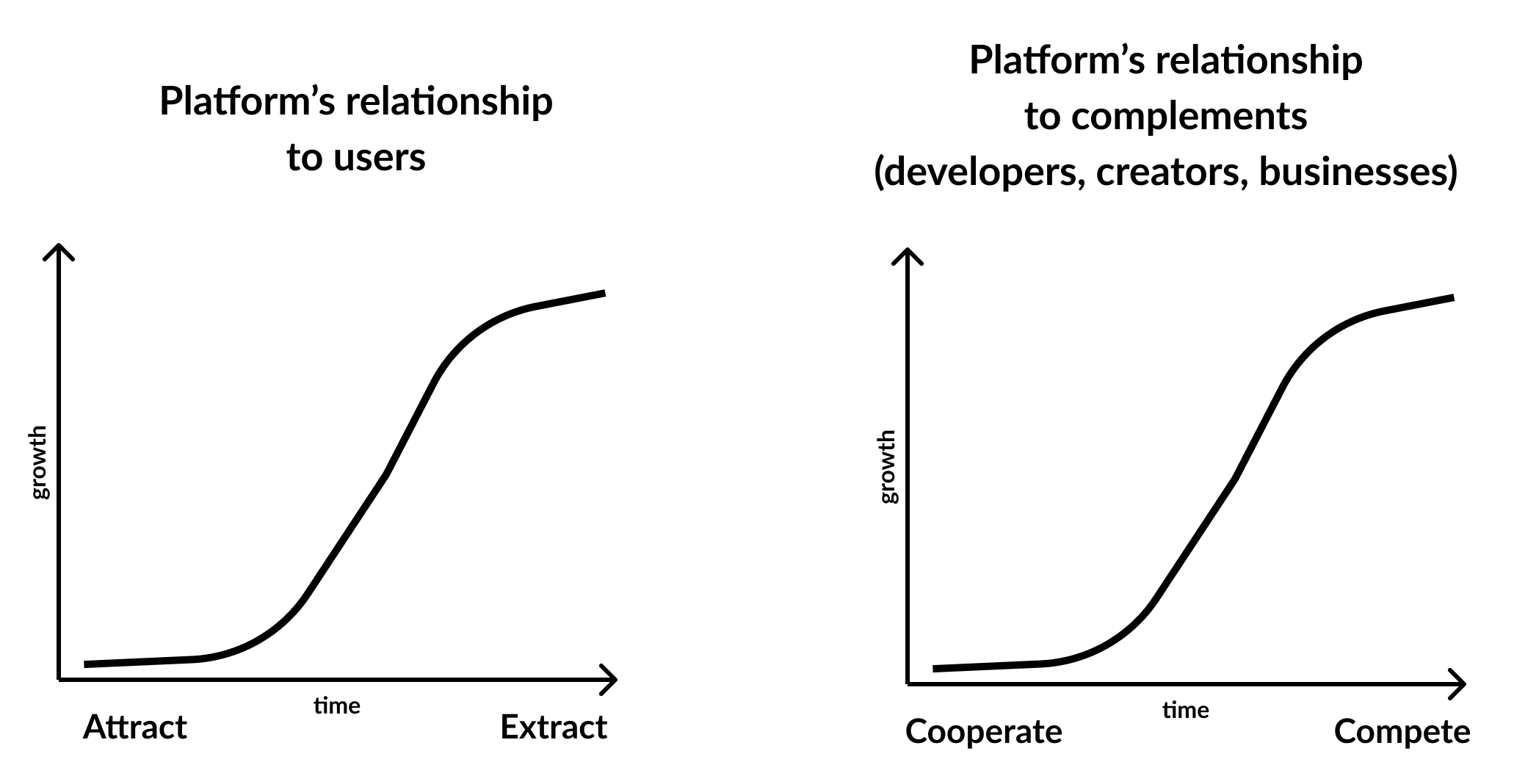
The API-fication of everything
We’re moving from “there is an app for that” to a world where “there is an API for that”, including commerce APIs. In this new world, rather than having to deal with proprietary frameworks and extension patterns, developers are now free to rapidly integrate a series of best-of-breed solutions together to meet the requirements specific to the business.
For more best of breed APIs, take a look at headlesscommerce.org
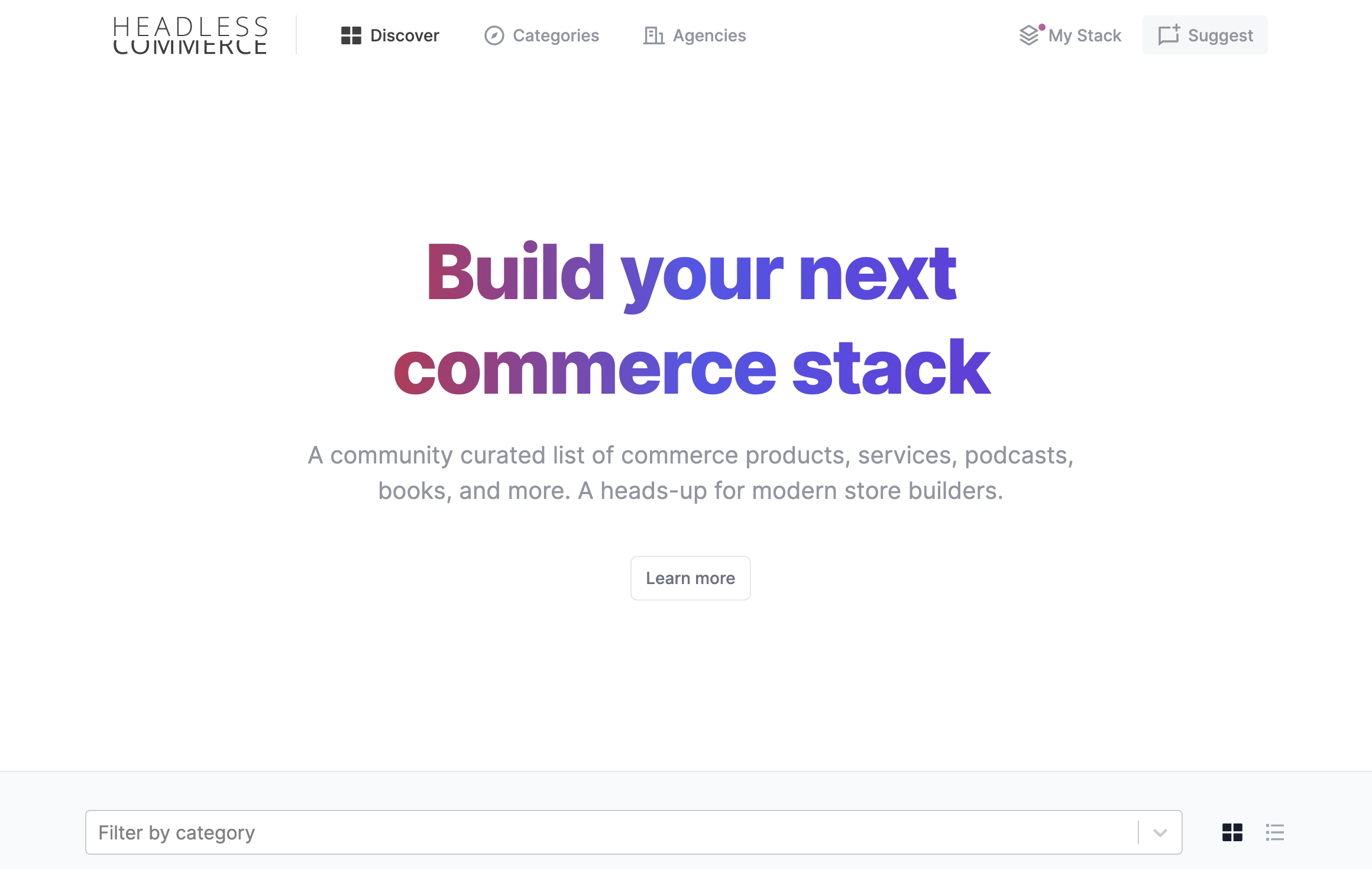
What is Commerce Infrastructure?
Here at Commerce.js, we believe that the time of the platform-centric approach is over; with the rise of best-of-breed APIs the value of the eCommerce platform has eroded for all but the simplest use cases. Commerce infrastructure provides the commerce logic and framework to stitch together dozens of best-of-breed APIs together whilst minimizing the challenges and complexities that this approach presents. This is an evolution of some of the MACH-based principles and an effort to push beyond the theory of Composable Commerce being dominated by platform-centric vendors.
Commerce infrastructure can be leveraged for both simple and complex use cases.
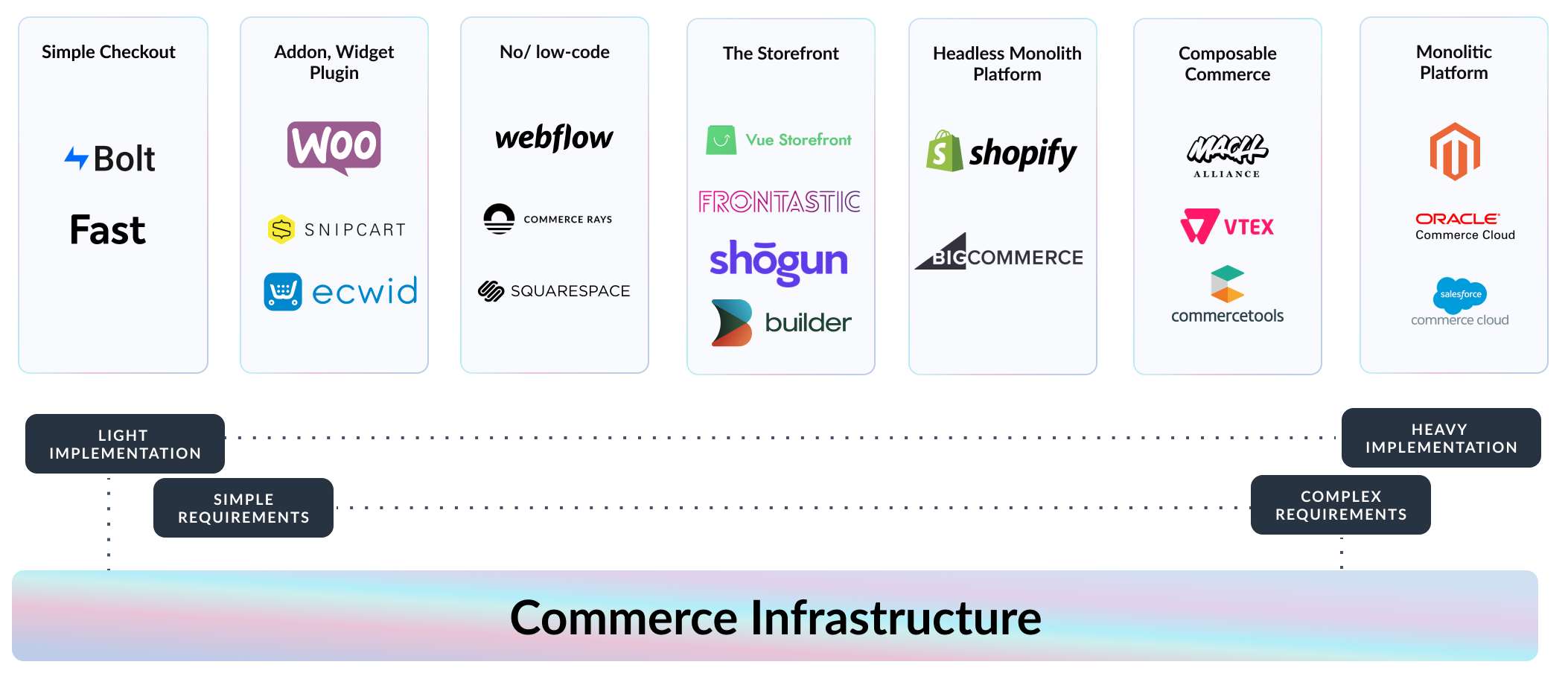
To achieve this, Commerce Infrastructure is focused on a high degrees of interoperability, turnkey frontend solutions and backend integrations by using common open source technologies and modern architecture patterns rather than a large list of features delivered by a single vendor. This ecosystem-centric, truly federated architectural approach creates equal opportunities for all, higher quality products for merchants and ultimately better end customer shopping experiences.
You’ll find no proprietary plugin, module or addon frameworks in a Commerce Infrastructure provider like Commerce.js.
To put it simply, Commerce Infrastructure reduces the cost and complexity of the MACH and Composable-based approach, and brings API-driven commerce to businesses of any size.
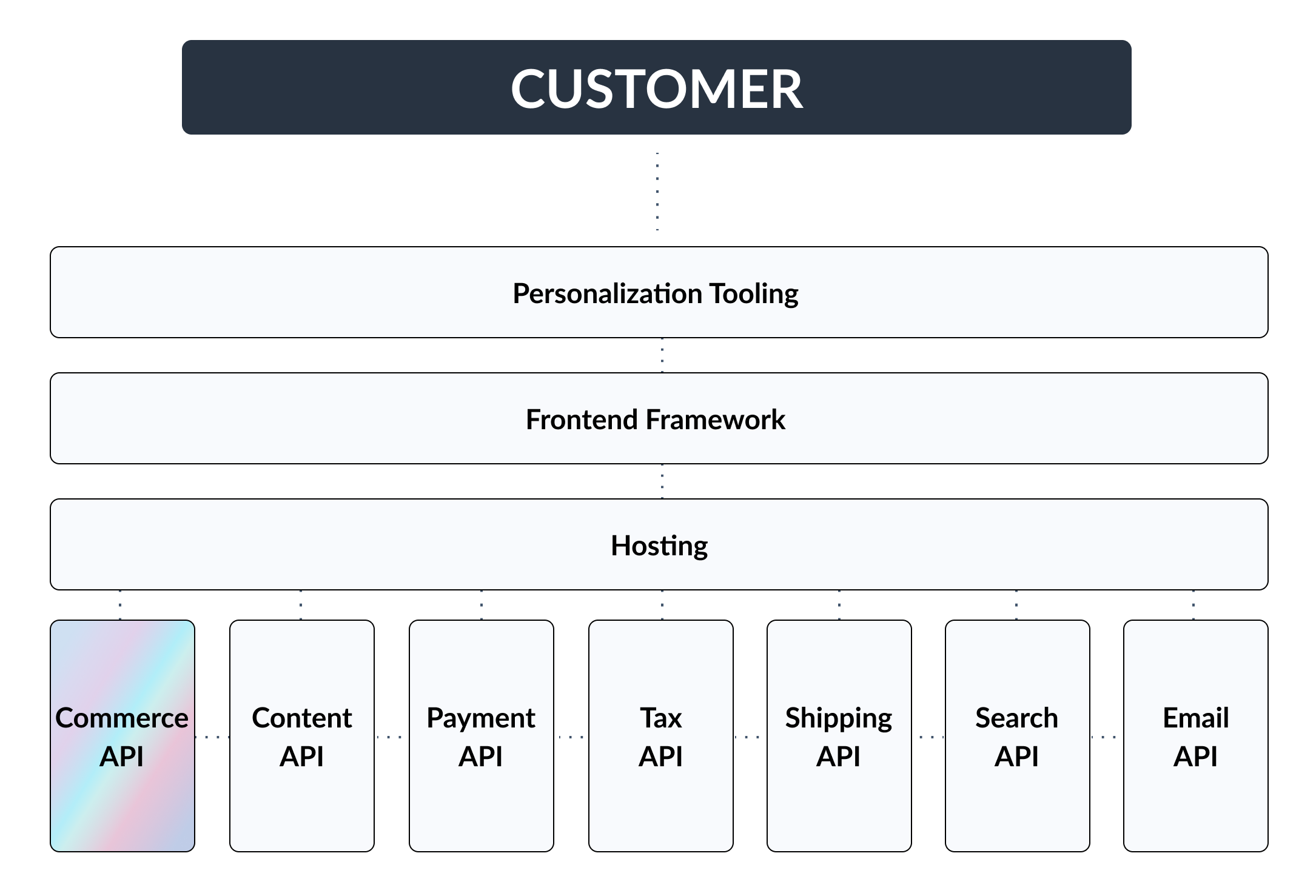
Why Commerce Infrastructure?
To build a differentiated, high performance, scalable commerce business, control at the infrastructure level gives businesses an advantage over your platform ridden competitors. Instead of relying on one platform that has a broad yet shallow offering, you can instead lean on best of breed providers to deliver core infrastructure where you need it most. Multiple services (content, commerce, search, email) all working together to deliver the best experiences for your customers.
Below we can see a traditional monolith and headless monolith architectures, and how they compare to the fully decoupled, modular, headless architecture on the right.
 Unpacking the decoupled architecture even more, below we can see Commerce.js acting as the Commerce Infrastructure in this business stack. Search, content, payment, tax, hosting and personalization are all being handled by best of breed, infra level services. This business is architecturally designed to scale, with the ability to leverage the deep capabilities of each provider as internal requirements change and customer demands evolve.
Unpacking the decoupled architecture even more, below we can see Commerce.js acting as the Commerce Infrastructure in this business stack. Search, content, payment, tax, hosting and personalization are all being handled by best of breed, infra level services. This business is architecturally designed to scale, with the ability to leverage the deep capabilities of each provider as internal requirements change and customer demands evolve.

Infrastructure ≠ complex & expensive
An infrastructure led approach to building a commerce business can be as simple and lightweight as you need it to be.
Below is an architecture diagram of Commerce.js powered business, Ira Concept. This headless, API-driven business was built in 3 weeks by a single frontend developer, of which ony 2 days were spent integrating with Commerce.js. The business stack consists of free tiered, open-source, and transaction based services that allowed Ira Concept to build their site for $0.
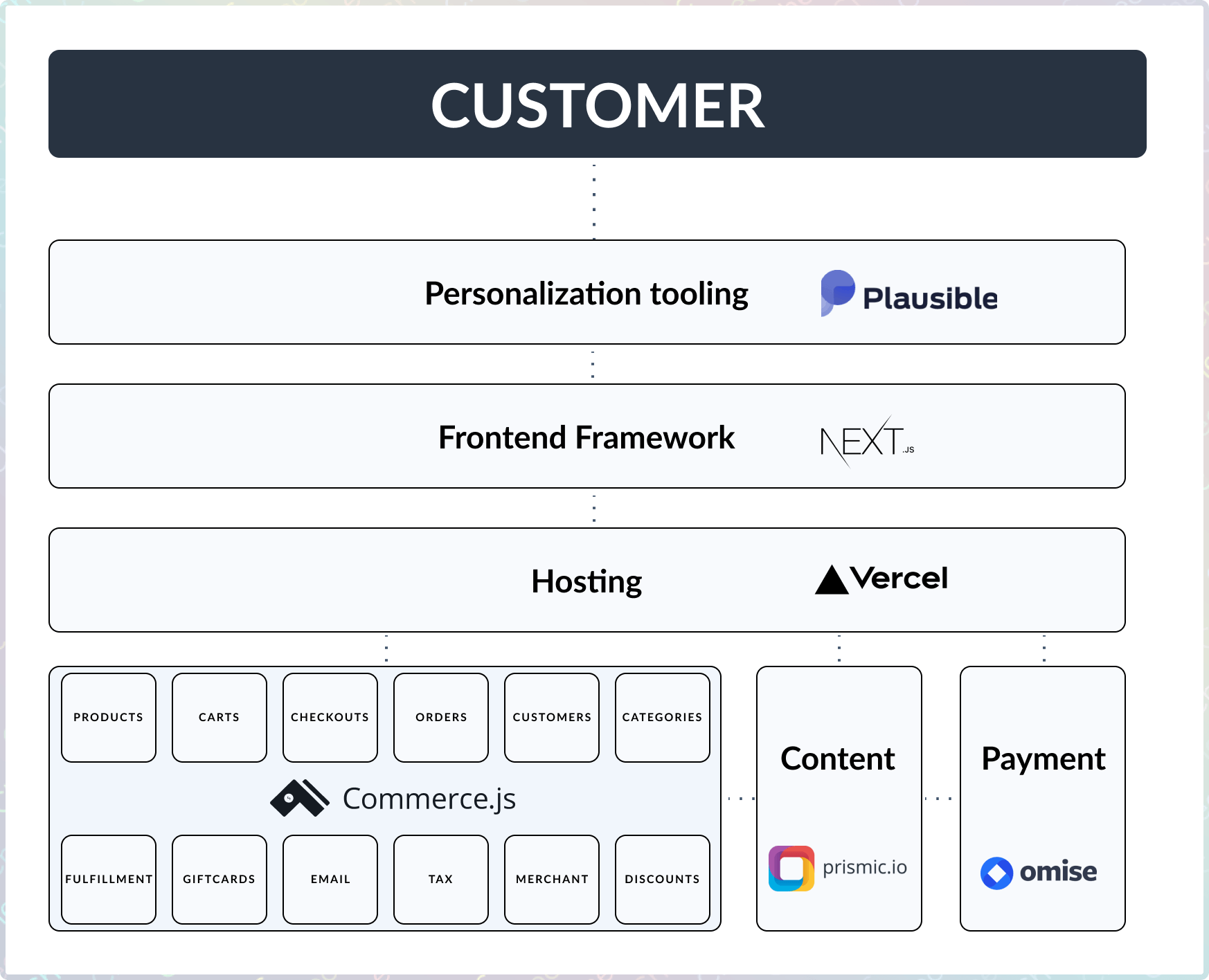 So who said commerce infrastructure has to be complex, expensive, and take a team of developers 6 months to go live!
So who said commerce infrastructure has to be complex, expensive, and take a team of developers 6 months to go live!
The power of infrastructure
What is a city without its infrastructure? The same goes for businesses who rely on the core tools that support their capabilities. Digital infrastructure services abstract away complexity, and delivers a paradigm shifting developer experience that gives businesses a foundation to build and scale on top of.
Some well known infrastructure led services:
- Stripe: Payments infrastructure for the internet
- Twilio: Communications infrastructure for the internet
- Algolia: Search infrastructure for the internet
Platforms vs Infrastructure TLDR
We’ve prepared a simple reference chart to make it easier to remember the difference between a commerce platform and commerce infrastructure below; cut out lines included.

Ready to take control of your commerce?
Leverage our headless backend to build product, cart, and checkout experiences as per your requirements.
Speak to our expert team or sign up for free today.
